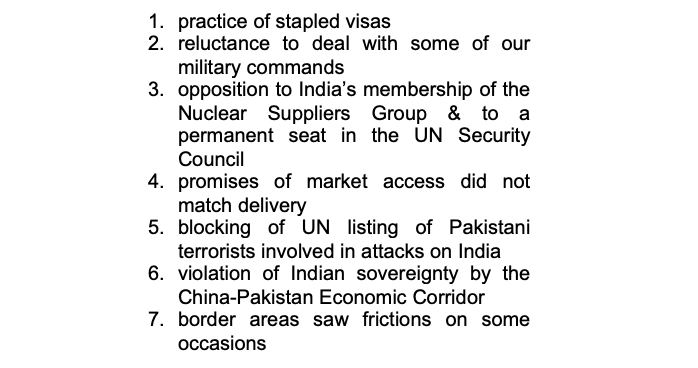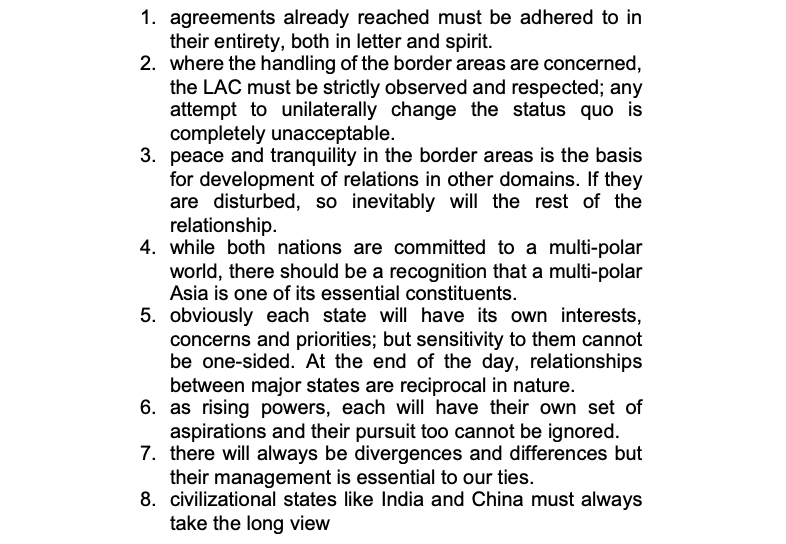 on
on 
 . Indian Foreign Minister @DrSJaishankar gave a speech today on India-China rels that is worth reading.
. Indian Foreign Minister @DrSJaishankar gave a speech today on India-China rels that is worth reading. I’ll highlight some bits, including the 7 divergences, the 3 mutuals, & 8 propositions that he outlined. 1/
https://mea.gov.in/Speeches-Statements.htm?dtl/33419/Keynote_Address_by_External_Affairs_Minister_at_the_13th_All_India_Conference_of_China_Studies
2/ One thing I will highlight up front is the Indian foreign minister's emphasis on the serious significance/impact of the 2020 boundary crisis.
He notes that, as a consequence,
 relationship
relationship
- “profoundly disturbed”
- “under exceptional stress”
- “truly at a crossroads”
He notes that, as a consequence,

 relationship
relationship- “profoundly disturbed”
- “under exceptional stress”
- “truly at a crossroads”
3/ Indian EAM noted the history, seemingly for a purpose
- Early Indian recognition of & ties w/ China
- Boundary crisis, 1962 war
- Adversely affected ties
- “Very painstaking and arduous” rebuilding
- Understandings, agmts to manage boundary dispute
- Expansion of broader rel
- Early Indian recognition of & ties w/ China
- Boundary crisis, 1962 war
- Adversely affected ties
- “Very painstaking and arduous” rebuilding
- Understandings, agmts to manage boundary dispute
- Expansion of broader rel
4/ So, what’s the purpose that I see of EAM outlining history? To show
- broader
 rel cannot be separated from behavior at the boundary
rel cannot be separated from behavior at the boundary
- Bad boundary behavior -> bad ties
- OTOH peace & tranquility at boundary -> advancement of ties (indeed latter predicated on former)
- broader

 rel cannot be separated from behavior at the boundary
rel cannot be separated from behavior at the boundary- Bad boundary behavior -> bad ties
- OTOH peace & tranquility at boundary -> advancement of ties (indeed latter predicated on former)
5/ In the speech, EAM Jaishankar notes Chinese actions in 2020 signaled
- “disregard for commitments about minimizing troop levels”
- “willingness to breach peace & tranquility”
- “change in China’s stance”
He says “yet to receive a credible explanation” for these actions.
- “disregard for commitments about minimizing troop levels”
- “willingness to breach peace & tranquility”
- “change in China’s stance”
He says “yet to receive a credible explanation” for these actions.
6/ EAM Jaishankar says that China's boundary actions mean India has to think about:
- what the Chinese posture signals
- how it evolves
- what implications it may have for the future of our ties
- what the Chinese posture signals
- how it evolves
- what implications it may have for the future of our ties
7/ EAM Jaishankar points out 
 friction isn’t new, outlining that pre-2020 there was cooperation (trade, investment, tourism, students, global issues, plurilaterals), but also 7 divergences or what can be called 7 Chinese "wrongs" related to India’s “interests & aspirations”
friction isn’t new, outlining that pre-2020 there was cooperation (trade, investment, tourism, students, global issues, plurilaterals), but also 7 divergences or what can be called 7 Chinese "wrongs" related to India’s “interests & aspirations”

 friction isn’t new, outlining that pre-2020 there was cooperation (trade, investment, tourism, students, global issues, plurilaterals), but also 7 divergences or what can be called 7 Chinese "wrongs" related to India’s “interests & aspirations”
friction isn’t new, outlining that pre-2020 there was cooperation (trade, investment, tourism, students, global issues, plurilaterals), but also 7 divergences or what can be called 7 Chinese "wrongs" related to India’s “interests & aspirations”
8/ As an aside, some of these 7 "wrongs" did not just precede 2020 but also Xi Jinping as China's leader.
This fits with when many in GoI have generally traced growing Chinese assertiveness to -- around 2008
This fits with when many in GoI have generally traced growing Chinese assertiveness to -- around 2008
9/ In the speech, Jaishankar notes the 2017 understanding between Modi & Xi:
- not to allow differences to become disputes
- to enhance the factors of stability in the relationship
He indicates the 2020 boundary crisis has violated both
- not to allow differences to become disputes
- to enhance the factors of stability in the relationship
He indicates the 2020 boundary crisis has violated both
10/ Jaishankar puts the ball in Beijing’s court. Says doesn’t know where relationship is going but makes clear that it has to be based on respect for
- 3 mutuals (respect, sensitivity, interests)
- 8 propositions (req respect agmts, reciprocity, space for India, managing diff)
- 3 mutuals (respect, sensitivity, interests)
- 8 propositions (req respect agmts, reciprocity, space for India, managing diff)
11/ Beijing has called for setting boundary issue aside & not letting it affect broader ties.
Jaishankar reiterates: “Any expectation that [3 mutuals] can be brushed aside, & that life can carry on undisturbed despite the situation at the border, that is simply not realistic."
Jaishankar reiterates: “Any expectation that [3 mutuals] can be brushed aside, & that life can carry on undisturbed despite the situation at the border, that is simply not realistic."
12/ His speech ends with saying that Sino-Indian differences could “undermine” the Asian century.
“The India-China relationship is today truly at a crossroads. Choices that are made will have profound repercussions, not just for the two nations but for the entire world.”
“The India-China relationship is today truly at a crossroads. Choices that are made will have profound repercussions, not just for the two nations but for the entire world.”
13/ GoI officials have outlined elements of this speech before, but this speech puts it together & explicitly outlines
- what's gone wrong in the China rel (tho not covering boundary devps, which the DefMin did in parliament to some extent)
- what it'll take to stabilize it
- what's gone wrong in the China rel (tho not covering boundary devps, which the DefMin did in parliament to some extent)
- what it'll take to stabilize it
14/ So, why give the speech now? I'm still thinking that through. It's obviously meant primarily as a message to China, but could also have domestic & other int'l audiences.
Possible they see a window & Beijing as uncertain abt Biden & looking to stabilize ties w/ US partners.
Possible they see a window & Beijing as uncertain abt Biden & looking to stabilize ties w/ US partners.
15/ Regardless, even if boundary stabilizes, it wld be hard - if not impossible - for India-China ties to go back to normal.
Even if China agrees w/ 8 propositions (which is a reach), there'll be such little, if any, trust that Beijing will stick to any agreements/understandings
Even if China agrees w/ 8 propositions (which is a reach), there'll be such little, if any, trust that Beijing will stick to any agreements/understandings
16/ And before some of y'all go and write your reset 2.0 headlines, pause. Absent a major & sustained positive shift in Chinese behavior:
- India's view of China as a challenge isn't going anywhere
- its desire to build & participate in balancing coalitions isn't going anywhere
- India's view of China as a challenge isn't going anywhere
- its desire to build & participate in balancing coalitions isn't going anywhere
(14a/ I'm going to let others speculate more re possible reasons for the timing of the speech, including developments -- or lack of them -- at the boundary or in mil/diplo talks or any other factors. I don't know for sure the reason or what's happening in talks/at the boundary)
17/ EAM noted Indian mil's efforts to stem PLA advances & renewed efforts to improve boundary infra (which preceded 2014)
But it's perhaps in this internal balancing/bldg cap. realm where GoIs, incl this one, hv just not done enough. Wld req hard choices. https://timesofindia.indiatimes.com/blogs/voices/china-policy-needs-rethink-but-india-cant-take-forever-to-do-it/
But it's perhaps in this internal balancing/bldg cap. realm where GoIs, incl this one, hv just not done enough. Wld req hard choices. https://timesofindia.indiatimes.com/blogs/voices/china-policy-needs-rethink-but-india-cant-take-forever-to-do-it/

 Read on Twitter
Read on Twitter



